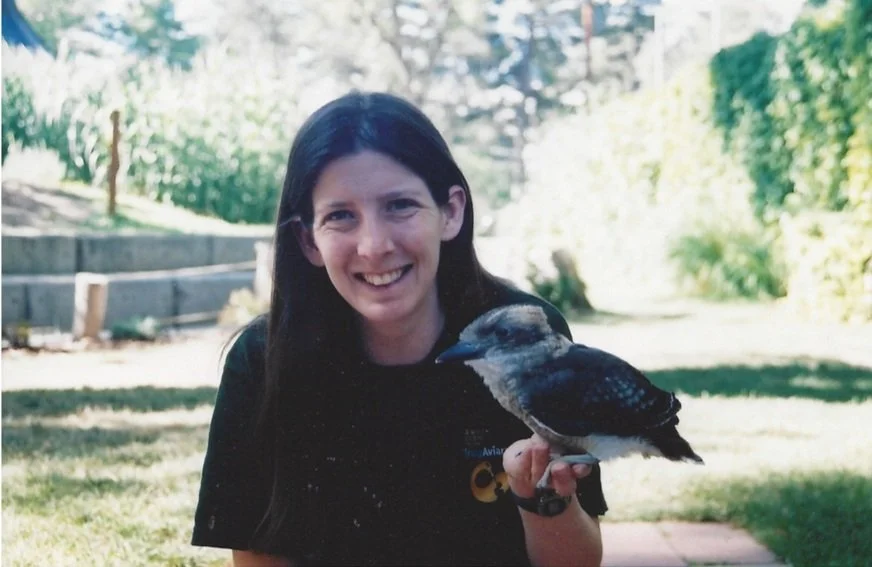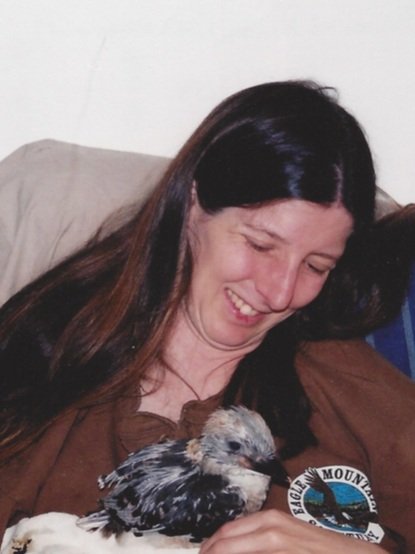My Life with Animals - Laughter
Back in 2004, I was working in Utah at an all bird facility. I was in charge of the Bird Show Department. Of the 450 birds at the facility, the 35 in my care were the ones who had the privilege of being trained and becoming ambassador animals. Most of the animals I got to care for either came from wildlife rehabilitation or were unwanted pets. It was rare that I got to raise a bird from one of the exhibit pairs, but because of a program called SSP, now was my chance.
The Species Survival Plan, or SSP, is a program that is run by the Association of Zoos and Aquariums (AZA) to manage the populations of animals in human care to ensure that we keep the genetic diversity for conservation efforts. There are different levels of severity among SSP animals and one is called PMP or the Propagation Management Program. The Laughing kookaburra was a PMP managed bird and we had a very prolific pair. They were currently sitting on three fertile eggs. The SSP coordinator said that their genes were over-represented and that we could only add two more birds into the population so we were going to have to pull one of the eggs. Instead, we asked if we could let all three develop and hatch and raise one by hand for education. They agreed, and so my journey with Kinta began. Her name was an Aboriginal word for Laughter and I knew that it was going to be perfect for her.
On June 10, 2004, a little egg, the size of a large grape cracked open and out came an alien being! Eyes sealed shut and bulging out with her head flopped over to the ground and a completely naked body, this strange little creature came into the world. She remained in the incubator for about a week and on day seven, she was given over to me. I was now officially mom and I had to feed her every few hours, keep her warm and make sure she was safe.
Kookaburras are predators and eat rodents, lizards and snakes. In the wild, mom would rip up a piece of food, hold it in her beak and enzymes would drip out of her nares to start the digestion process for the chick. Luckily for me, science has re-created these enzymes so I wouldn’t be pre-chewing any food for her. She was a great eater, I never had any issues with giving her food. The Laughing Kookaburra gets its name from their cackling call which sounds like they are laughing hysterically. When you hear it, you cannot help but start laughing yourself. I really wanted to teach her to call on cue. Throughout the day, every day I would do my best kookaburra laugh. Although it really didn’t sound anything like a kookaburra, Kinta didn’t know any better and she would return my call with hers. She was much better at it than I was.
Kinta went everywhere with me. I carried her in a little portable incubator so that she would always be warm. It didn’t matter where I was, Kinta was right there with me. Everyone loved her. I would take her out and feed her with friends and visitors. As she got bigger and started growing in her feathers I was able to take her out longer and longer. I used a little black rubber water dish to make a nest for her and would just sit with us. As her feathers were growing in she looked like a pin cushion. She was becoming so cute and her beauty was soon to follow.
I will never forget taking her on the news in Park City. There were two anchors and the woman was terrified of birds. As I took the little bowl nest out of the kennel, she gasped and jumped back in fear. There sat this helpless little pincushion who couldn’t even climb out of the nest and this full grown woman scared to death. It was the funniest scene ever.
One day in late summer of 2004, I sat with my other trainer on the stage grass of the Bird Show Building. Kinta was hopping around on my arm when suddenly, she leaped off, flapped her wings and took off. It was her first flight!! While this would normally be a happy occasion, like your child taking her first steps, imagine if those first steps were running around the corner and out of sight. We went running, as she turned the corner of the building. A birds’ first flight is usually short and awkward, but not for Kinta. With full force, she was off and flying like a 12 year old on their first dirt bike! “Where is she”? I asked with a bit of concern in my voice. “I don’t know, I didn’t see” she replied with as much panic as mine. “She couldn’t be far” we both said, but we couldn’t find her well camouflaged body in the trees. Kinta would make the laugh of the kookaburra in response to us. “Start calling” I said with an edge of pleading. We started calling to her, over and over again. There was no reply. We knew she had to be right nearby, but she always answers, so maybe she got around the next corner faster than we thought. So we kept walking around, spreading out and calling to her more. But still, there was no answer.
“We need more eyes out here, Kinta took her first flight and is gone!”, I called over the radio to the rest of the Aviculture staff. As people arrived, we spread everyone out and instructed everyone on her call. The facility sat on the edge of a large park and that was the direction she was going, so that is where my trainer and I headed.
For hours we walked around calling. People in the park were looking at us like we were crazy, but we didn’t care. Soon concern turned to despair as we wandered deeper and deeper into the park. Four hours had passed, when suddenly from the radio I heard, “I think I found her”. It was one of the aviculturists. “Where are you”?, I asked with excitement. “Back at the Aviary” he said. We turned and went running back. “Where is she”? I questioned upon my return. “I’m not sure, but I was just walking by and I heard her call from over there”. He pointed to a group of trees exactly where we first thought she had landed. We started calling and sure enough, she responded and then from the nearby tree, she gently flew down to my hand. After the weight of the World lifted from my shoulders, I quickly, but steadily walked her back to the Building.
Although that day scared me to the point where I wouldn’t fly her outdoors anymore, she has flown in hundreds of educational shows for thousands of people. She flies no matter where I take her and to anyone I ask. This summer, however, after 15 years, I got up the nerve and gave her a chance to be a star in our big summer outdoor shows. And a star she was! Over 20,000 people got to experience her flying right over their heads like an arrow being shot through the air. It was as if she had been doing it her entire life.
After 15 years with Kinta she still calls to me every time she sees me. A little cackle from me and she throws back her head in a chorus of laughter. This little bird has made tens of thousands of people laugh throughout the years as she throws her head back calling out in her boisterous laughter. From the first day I met her, I knew that she was going to change my life.








